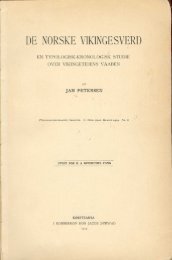The Japanese sword and its fittings, from the collections ... - KnifeHelp
The Japanese sword and its fittings, from the collections ... - KnifeHelp
The Japanese sword and its fittings, from the collections ... - KnifeHelp
Create successful ePaper yourself
Turn your PDF publications into a flip-book with our unique Google optimized e-Paper software.
48<br />
GLOSSARY<br />
DAI - SHO - A katana <strong>and</strong> wakizashi in matched <strong>fittings</strong>; sets of <strong>fittings</strong> alone,<br />
such as: a set of tsuba for daito <strong>and</strong> wakizashi.<br />
HAMON - Pattern of yakiba (tempered edge).<br />
HORI - Carving. Found both on blades <strong>and</strong> <strong>the</strong>ir <strong>fittings</strong>.<br />
IROYE<br />
KAKIHAN - Written seal. Artist's mark.<br />
KATA - KIRI - BORl - Chiseling in lines of varying thickness <strong>and</strong> depth, resembling<br />
brush strokes.<br />
KATANA - Sword. Sometimes refers only to long <strong>sword</strong>s (daito) as distinct <strong>from</strong><br />
- "Colored picture." A type of inlay in which a variety of alloys are used.<br />
short <strong>sword</strong>s (wakizashi).<br />
KATCHUSHI - Armor-maker. Katchushi tsuba; tsuba produced by armor-makers.<br />
KE - BORl - Chiseling in lines of even thickness <strong>and</strong> depth.<br />
KINKO - Gold workers. Artisans who produced decorative <strong>sword</strong> <strong>fittings</strong> during<br />
<strong>the</strong> Edo period (1590-1868).<br />
KIN -MEI - An appraiser's attribution in gold inlay on <strong>the</strong> nakago (tang).<br />
KOGAI - Skewer. Usually accompanied by a kozuka (utility knife) <strong>and</strong> inserted<br />
in separate pocket in <strong>the</strong> soya (scabbard).<br />
KOTO - Blades made prior to 1600.<br />
KOZUKA - Utility knife. Inserted in a separate pocket in <strong>the</strong> soya (scabbard).<br />
Consists of a h<strong>its</strong>u (h<strong>and</strong>le) <strong>and</strong> a ho (blade).<br />
MARU - BORl - Figures chiseled in <strong>the</strong> round.<br />
MENUKI - Metal ornaments on ei<strong>the</strong>r side of <strong>the</strong> tsuka.<br />
NAGAMAKl; NAGINATA - Halberd - like polearms.<br />
NAMBAN - Sou<strong>the</strong>rn barbarians. Also refers to items of foreign (European) influence.<br />
NANAKO — Jl - "Fish roe" ground. Produced by hammering with a hollow punch.<br />
SENTOKU - Brass-like alloy containing tin <strong>and</strong> lead.<br />
SHAKUDO - Copper with <strong>from</strong> 0.5% to 5% gold added. Colors range <strong>from</strong> brownish —<br />
bronze to blui sh - black after pickling.<br />
SHIBUICHI - Copper with 13% to 25% silver added. Results in different shades<br />
of silverish —gray after pickling.<br />
SHIN -SHINTO - Swords made during <strong>the</strong> period 1800 to 1868.<br />
SHINTO - Blades made during <strong>the</strong> period 1600 to 1800.<br />
SHOWA-TO - Blades made during <strong>the</strong> Showa era (1926 to present).<br />
SUKASHl — Perforation in positive or negative silhouette.<br />
TACHI — An ancient type of <strong>sword</strong> mounting in which <strong>the</strong> <strong>sword</strong> was worn suspended<br />
<strong>from</strong> <strong>the</strong> obi (sash) on <strong>the</strong> left side with <strong>the</strong> cutting-edge down.<br />
TANTO - Dagger, <strong>the</strong> cutting—edge of which is less than twelve inches in length.<br />
TSUBA - Sword guard.<br />
USU -NIKU - BORl - Chiseling in low relief.<br />
WAKIZASHI - Short <strong>sword</strong>, <strong>the</strong> cutting-edge of which is between twelve <strong>and</strong><br />
ZOGAN - Inlay.<br />
twenty-four inches in length.



